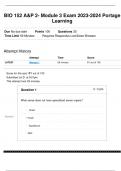Exam 3 ap bio - Study guides, Class notes & Summaries
Looking for the best study guides, study notes and summaries about Exam 3 ap bio? On this page you'll find 114 study documents about Exam 3 ap bio.
Page 2 out of 114 results
Sort by
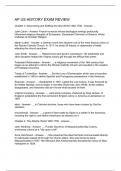
-
AP GOVERNMENT REVIEW SET 2 Exam (elaborations) APES Unit 1 Q&A 3 Exam (elaborations) AP BIO FR QUESTIONS AND ANSWERS 4 Exam (elaborations) AP BIO CH.2 AP Q&A 5 Exam (elaborations) AP Gov Exam 2023 Q&A 6 OTHER AP Human Geography Exam Review 7 OTHER A
- Package deal • 7 items • 2023
-
- $30.49
- + learn more
AP GOVERNMENT REVIEW SET 2 Exam (elaborations) APES Unit 1 Q&A 3 Exam (elaborations) AP BIO FR QUESTIONS AND ANSWERS 4 Exam (elaborations) AP BIO CH.2 AP Q&A 5 Exam (elaborations) AP Gov Exam 2023 Q&A 6 OTHER AP Human Geography Exam Review 7 OTHER AP US History Exam Review
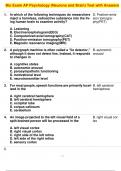
-
Bio Exam AP Psychology (Neurons and Brain) Test with Answers
- Exam (elaborations) • 12 pages • 2024
-
- $10.89
- + learn more
Bio Exam AP Psychology (Neurons and Brain) Test with Answers 1. In which of the following techniques do researchers inject a harmless, radioactive substance into the liv- ing human brain to examine activity? A. Lesioning B. Electroencephalogram(EEG) C. Computerized axial tomography(CAT) D. Positron-emission tomography(PET) E. Magnetic resonance imaging(MRI) 2. A polygraph machine is often called a "lie detector," although it does not detect lies. Instead, it responds to changes ...
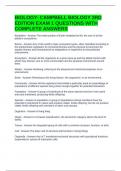
-
CAMPBELL BIOLOGY EXAM BUNDLE (GRADED A+) (100% GUARANTEED PASS)
- Package deal • 41 items • 2024
-
- $45.49
- + learn more
TEST #1: BIO CAMPBELL 10TH ED CHAPTERS 1, 2, AND 3 (MARTINEZ CYNTHIA) EXAM QUESTIONS WITH COMPLETE ANSWERS 2 Exam (elaborations) FINAL EXAM CAMPBELL S BIOLOGY CHAPTERS #1-17 QUESTIONS WITH CORRECT ANSWERS 3 Exam (elaborations) CHAPTERS 1-4 CAMPBELL BIO TEST QUESTIONS WITH CORRECT ANSWERS 4 Exam (elaborations) CHAPTER 44 AP BIO TEST PREPARATION,
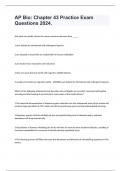
-
AP Bio: Chapter 43 Prediction Practice Exam Questions 2024.
- Exam (elaborations) • 24 pages • 2024
-
Available in package deal
-
- $10.99
- + learn more
AP Bio: Chapter 43 Prediction Practice Exam Questions 2024. Hot spots are usually chosen for nature preserves because they _____. habitat for threatened and endangered species situated in areas that are undesirable for human habitation located near mountains and volcanoes are areas that are sterile with regard to wildlife disease ly are located on migratory paths - ANSWER save habitat for threatened and endangered species Which of the following statements best describes w...
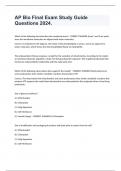
-
AP Bio Final Exam Study Guide Questions 2024.
- Exam (elaborations) • 6 pages • 2024
-
Available in package deal
-
- $10.99
- + learn more
AP Bio Final Exam Study Guide Questions 2024. Which of the following best describes the numbered areas? - CORRECT ANSWER Areas 1 and 3 are polar, since the membrane molecules are aligned with water molecules. Correct. As indicated in the diagram, the heads of the phospholipids in areas 1 and 3 are adjacent to water molecules, which shows that the phospholipid heads are hydrophilic. The endosymbiont theory proposes a model for the evolution of mitochondria. According to the model, an anc...
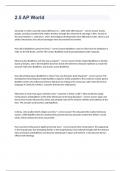
-
WELL AP WELL ACCREDITED PROFESSIONAL Package deal 2024
- Package deal • 53 items • 2024
-
- $45.49
- + learn more
Exam (elaborations) 2.5 AP World questions and answers verified 2024 Exam (elaborations) A&P 1 Exam #3 Review questions and answers verified 2024 Exam (elaborations) A&P Quiz 5 questions and answers verified 2024 Exam (elaborations) AAPC - Chapter 14 Review Exam questions and answers rated A+ 2024 Exam (elaborations) Ap Bio Unit 2 MCQ study
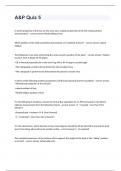
-
WELP AP Package deal 2024
- Package deal • 51 items • 2024
-
- $45.49
- + learn more
2.5 AP World. questions and answers rated A+ 2024 Exam (elaborations) A&P 1 Exam #3 Review questions and answers verified 2024 Exam (elaborations) A&P Quiz 5 questions and answers well elaborated 2024 Exam (elaborations) AAPC - Chapter 14 Review Exam questions with completed solutions 2024 Exam (elaborations) Ap Bio Unit 2 MCQ study guide q

-
Exam 2: BIO 117 / BIO 117 (Latest 2023/ 2024) Introduction to Anatomy and Physiology Exam Review| Complete Guide with Questions and Verified Answers| 100% Correct| Hondros
- Exam (elaborations) • 73 pages • 2023
-
Available in package deal
-
- $11.49
- + learn more
Exam 2: BIO 117 / BIO 117 (Latest 2023/ 2024) Introduction to Anatomy and Physiology Exam Review| Complete Guide with Questions and Verified Answers| 100% Correct| Hondros Q: Which muscle raises the eyebrows and wrinkles the forehead? Answer: frontalis Q: Which muscle assists in winking and blinking Answer: Orbicularis Oculli Q: Which muscle assists with smiling, raising the corners of the mouth) Answer: Zygomaticus Q: Which muscle allows you to pucker a...
BIO 152 A&P 2- Module 3 Exam Portage Learning
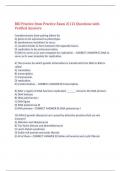
-
BIO Practice from Practice Exam 2|112 Questions with Verified Answers,100% CORRECT
- Exam (elaborations) • 29 pages • 2024
-
- $11.49
- + learn more
BIO Practice from Practice Exam 2|112 Questions with Verified Answers Complementary base-pairing allows for A) genes to be expressed as phenotype. B) spontaneous mutations to occur. C) covalent bonds to form between the opposite bases. D) replication to be semiconservative. E) DNA to serve as its own template for replication. - CORRECT ANSWER E) DNA to serve as its own template for replication. 6) The process by which genetic information is transferred from DNA to RNA is called ...

How did he do that? By selling his study resources on Stuvia. Try it yourself! Discover all about earning on Stuvia



